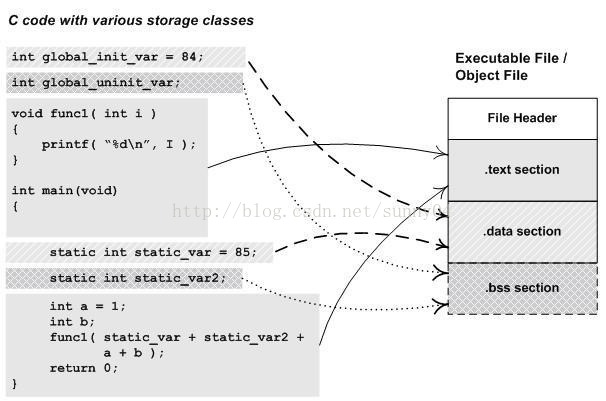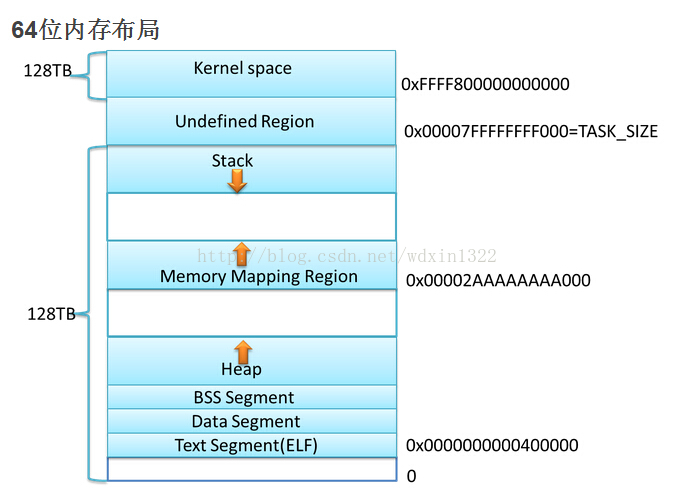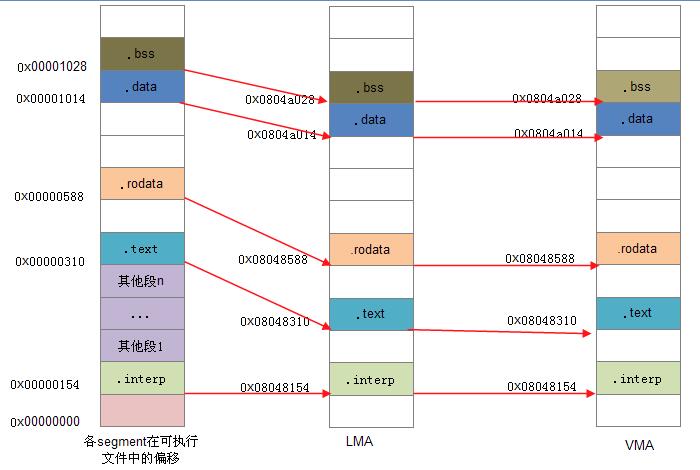数据段、代码段、堆栈段、BSS段的区别
本文结合实际的例子讲述一下数据段、代码段、堆栈段以及BSS段。
1. Linux段管理
在Linux下内存分配是以页为单位的,而页是通过段管理,各个段之间是独立的,方便管理。一个简单的程序被编译成目标文件后的结构如下:

从上图可以看出,已初始化的全局变量和局部静态变量保存在.data段中,未初始化的全局变量和未初始化的局部静态变量保存在.bss段中。
目标文件各个段在文件中的布局如下:

下面我们介绍一下各个段:
- init段
程序初始化入口代码,在main()之前运行。
- bss段
BSS段属于静态内存分配。通常是指用来存放程序中未初始化的全局变量和未初始化的局部静态变量。未初始化的全局变量和未初始化的局部静态变量默认值是0,本来这些变量也可以放到data段的,但是因为它们都是0,所以它们在data段分配空间并且存放数据0是没有必要的。
在程序运行时,才会给BSS段里面的变量分配内存空间。
在目标文件(*.o)和可执行文件中,BSS段只是为未初始化的全局变量和未初始化的局部静态变量预留位置而已,它并没有内容,所以它不占据空间。
section table中保存了BSS段(未初始化的全局变量和未初始化的局部静态变量)内存空间大小总和。可以通过objdump -h *.o命令查看到。
- data段
数据段(data segment)通常是指用来存放程序中已初始化的全局变量和已初始化的静态变量的一块内存区域。数据段属于静态内存分配。
- text段
代码段(code segment / text segment)通常是指用来存放程序执行代码的一块内存区域。这部分区域的大小在程序运行前就已经确定,并且内存区域通常属于只读,某些架构也允许代码段为可写,即允许修改程序。在代码段中,也有可能包含一些只读的常数变量,例如字符串常量等。
- rodata段
存放的是只读数据,比如字符串常量,全局const变量和#define定义的常量。本段又称为常量区。例如:
char *p = "123456";
这里123456就存放在rodata段中。
但是注意,并不是所有的常量都放在rodata段的,其特殊情况如下:
1) 有些立即数与指令编译在一起直接放在代码段;
2) 对于字符串常量,编译器会去掉重复的常量,让程序的每个字符串常量只有一份
3) 有些系统中rodata段是多个进程共享的,目的是为了提高空间的利用率
- strtab段
存储的是变量名、函数名等。例如:
char *szPath = "/root"; void func();
上述变量名szPath和函数名func存储在strtab段里。
- shstrtab段
bss、text、data等段名也存储在这里。
- rel.text段
针对text段的重定位表,还有rel.data(针对data段的重定位表)
- heap堆
堆是用于存放进程运行中被动态分配的内存段,它的大小并不固定,可动态扩张或缩减。当进程调用malloc()等函数分配内存时,新分配的内存就被动态添加到堆上(堆被扩张);当利用free()等函数释放内存时,被释放的内存从堆中被剔除(堆被缩减)。
- stack栈
是用户存放程序临时创建的局部变量,也就是说我们函数括弧{}中定义的变量(但不包括static声明的变量,static意味着在数据段中存放变量)。除此以外,在函数被调用时,其参数也会被压入发起调用的进程栈中,并且待到调用结束后,函数的返回值也会被存放回栈中。由于栈的先进后出特点,所以栈特别方便用来保存/恢复调用现场。从这个意义上讲,我们可以把栈看成一个寄存、交换临时数据的内存区。

2. 示例
2.1 示例代码
#include <stdio.h>
int a_test;
const int b_test = 2;
static int c_test = 3;
static int d_test;
int e_test = 0;
char *p_test = "hello,world";
const char *q_test = "good";
int main(int argc, char *argv[])
{
static int m_test;
static int n_test = 0;
char *s_test = "just for test";
printf("a: %d\n", a_test);
printf("b: %d\n", b_test);
printf("c: %d\n", c_test);
printf("d: %d\n", d_test);
printf("e: %d\n", e_test);
printf("p: %s\n", p_test);
printf("q: %s\n", q_test);
printf("m: %d\n", m_test);
printf("n: %d\n", n_test);
printf("s: %s\n", s_test);
return 0x0;
}通过下面的命令逐步编译运行上面test.c程序:
# gcc -S -o test.s test.c # gcc -c -o test.o test.s # gcc -o test test.o # ls test test.c test.o test.s
2.2 查看test可执行文件布局
# objdump -h test
test: file format elf32-i386
Sections:
Idx Name Size VMA LMA File off Algn
0 .interp 00000013 08048154 08048154 00000154 2**0
CONTENTS, ALLOC, LOAD, READONLY, DATA
1 .note.ABI-tag 00000020 08048168 08048168 00000168 2**2
CONTENTS, ALLOC, LOAD, READONLY, DATA
2 .note.gnu.build-id 00000024 08048188 08048188 00000188 2**2
CONTENTS, ALLOC, LOAD, READONLY, DATA
3 .gnu.hash 00000020 080481ac 080481ac 000001ac 2**2
CONTENTS, ALLOC, LOAD, READONLY, DATA
4 .dynsym 00000050 080481cc 080481cc 000001cc 2**2
CONTENTS, ALLOC, LOAD, READONLY, DATA
5 .dynstr 0000004c 0804821c 0804821c 0000021c 2**0
CONTENTS, ALLOC, LOAD, READONLY, DATA
6 .gnu.version 0000000a 08048268 08048268 00000268 2**1
CONTENTS, ALLOC, LOAD, READONLY, DATA
7 .gnu.version_r 00000020 08048274 08048274 00000274 2**2
CONTENTS, ALLOC, LOAD, READONLY, DATA
8 .rel.dyn 00000008 08048294 08048294 00000294 2**2
CONTENTS, ALLOC, LOAD, READONLY, DATA
9 .rel.plt 00000010 0804829c 0804829c 0000029c 2**2
CONTENTS, ALLOC, LOAD, READONLY, DATA
10 .init 00000023 080482ac 080482ac 000002ac 2**2
CONTENTS, ALLOC, LOAD, READONLY, CODE
11 .plt 00000030 080482d0 080482d0 000002d0 2**4
CONTENTS, ALLOC, LOAD, READONLY, CODE
12 .plt.got 00000008 08048300 08048300 00000300 2**3
CONTENTS, ALLOC, LOAD, READONLY, CODE
13 .text 00000262 08048310 08048310 00000310 2**4
CONTENTS, ALLOC, LOAD, READONLY, CODE
14 .fini 00000014 08048574 08048574 00000574 2**2
CONTENTS, ALLOC, LOAD, READONLY, CODE
15 .rodata 00000071 08048588 08048588 00000588 2**2
CONTENTS, ALLOC, LOAD, READONLY, DATA
16 .eh_frame_hdr 0000002c 080485fc 080485fc 000005fc 2**2
CONTENTS, ALLOC, LOAD, READONLY, DATA
17 .eh_frame 000000cc 08048628 08048628 00000628 2**2
CONTENTS, ALLOC, LOAD, READONLY, DATA
18 .init_array 00000004 08049f08 08049f08 00000f08 2**2
CONTENTS, ALLOC, LOAD, DATA
19 .fini_array 00000004 08049f0c 08049f0c 00000f0c 2**2
CONTENTS, ALLOC, LOAD, DATA
20 .jcr 00000004 08049f10 08049f10 00000f10 2**2
CONTENTS, ALLOC, LOAD, DATA
21 .dynamic 000000e8 08049f14 08049f14 00000f14 2**2
CONTENTS, ALLOC, LOAD, DATA
22 .got 00000004 08049ffc 08049ffc 00000ffc 2**2
CONTENTS, ALLOC, LOAD, DATA
23 .got.plt 00000014 0804a000 0804a000 00001000 2**2
CONTENTS, ALLOC, LOAD, DATA
24 .data 00000014 0804a014 0804a014 00001014 2**2
CONTENTS, ALLOC, LOAD, DATA
25 .bss 00000018 0804a028 0804a028 00001028 2**2
ALLOC
26 .comment 00000035 00000000 00000000 00001028 2**0
CONTENTS, READONLY
1) VMA和LMA
我们先简要介绍一下VMA和LMA这两个字段:
-
VMA(virtual memory address): 程序区段在执行时期的地址 -
LMA(load memory address): 某程序区段加载时的地址。因为我们知道程序运行前要经过:编译、链接、装载、运行等过程。装载到哪里呢? 没错,就是LMA对应的地址里。
一般情况下,LMA和VMA都是相等的,不等的情况主要发生在一些嵌入式系统上。
2) segment布局
如下我们简要的画出各区段的一个布局:

其实这里我们看到尽管bss段长度为0x00000018,但是我们看到.bss段和.comment段在文件中的偏移是一样的,这就说明bss段数据是不用包含在可执行程序中的。
2.3 汇编文件test.s分析
# cat test.s
.file "test.c"
.comm a_test,4,4
.globl b_test
.section .rodata
.align 4
.type b_test, @object
.size b_test, 4
b_test:
.long 2
.data
.align 4
.type c_test, @object
.size c_test, 4
c_test:
.long 3
.local d_test
.comm d_test,4,4
.globl e_test
.bss
.align 4
.type e_test, @object
.size e_test, 4
e_test:
.zero 4
.globl p_test
.section .rodata
.LC0:
.string "hello,world"
.data
.align 4
.type p_test, @object
.size p_test, 4
p_test:
.long .LC0
.globl q_test
.section .rodata
.LC1:
.string "good"
.data
.align 4
.type q_test, @object
.size q_test, 4
q_test:
.long .LC1
.section .rodata
.LC2:
.string "just for test"
.LC3:
.string "a: %d\n"
.LC4:
.string "b: %d\n"
.LC5:
.string "c: %d\n"
.LC6:
.string "d: %d\n"
.LC7:
.string "e: %d\n"
.LC8:
.string "p: %s\n"
.LC9:
.string "q: %s\n"
.LC10:
.string "m: %d\n"
.LC11:
.string "n: %d\n"
.LC12:
.string "s: %s\n"
.text
.globl main
.type main, @function
main:
.LFB0:
.cfi_startproc
leal 4(%esp), %ecx
.cfi_def_cfa 1, 0
andl $-16, %esp
pushl -4(%ecx)
pushl %ebp
.cfi_escape 0x10,0x5,0x2,0x75,0
movl %esp, %ebp
pushl %ecx
.cfi_escape 0xf,0x3,0x75,0x7c,0x6
subl $20, %esp
movl $.LC2, -12(%ebp)
movl a_test, %eax
subl $8, %esp
pushl %eax
pushl $.LC3
call printf
addl $16, %esp
movl $2, %eax
subl $8, %esp
pushl %eax
pushl $.LC4
call printf
addl $16, %esp
movl c_test, %eax
subl $8, %esp
pushl %eax
pushl $.LC5
call printf
addl $16, %esp
movl d_test, %eax
subl $8, %esp
pushl %eax
pushl $.LC6
call printf
addl $16, %esp
movl e_test, %eax
subl $8, %esp
pushl %eax
pushl $.LC7
call printf
addl $16, %esp
movl p_test, %eax
subl $8, %esp
pushl %eax
pushl $.LC8
call printf
addl $16, %esp
movl q_test, %eax
subl $8, %esp
pushl %eax
pushl $.LC9
call printf
addl $16, %esp
movl m_test.1942, %eax
subl $8, %esp
pushl %eax
pushl $.LC10
call printf
addl $16, %esp
movl n_test.1943, %eax
subl $8, %esp
pushl %eax
pushl $.LC11
call printf
addl $16, %esp
subl $8, %esp
pushl -12(%ebp)
pushl $.LC12
call printf
addl $16, %esp
movl $0, %eax
movl -4(%ebp), %ecx
.cfi_def_cfa 1, 0
leave
.cfi_restore 5
leal -4(%ecx), %esp
.cfi_def_cfa 4, 4
ret
.cfi_endproc
.LFE0:
.size main, .-main
.local m_test.1942
.comm m_test.1942,4,4
.local n_test.1943
.comm n_test.1943,4,4
.ident "GCC: (Ubuntu 5.4.0-6ubuntu1~16.04.10) 5.4.0 20160609"
.section .note.GNU-stack,"",@progbits在讲解各变量存放位置之前,我们先简要介绍一下.comm和.lcomm:
-
.comm: 声明为未初始化的通用内存区域;
-
.lcomm: 声明为未初始化的本地内存区域;
其实上述两个均是属于bss段,不过作用域范围有些不同。.lcomm是为不会从本地汇编代码之外进行访问的数据保留的。两者使用的格式为:
.comm symbol, length .lcomm symbol, length
例如:
.section .bss
.lcomm buffer, 1000该语句把1000字节的内存地址赋予标签buffer,在声明本地通用内存区域的程序之外的函数是不能访问他们的。
在bss段声明的好处是,数据不包含在可执行文件中。在数据段中定义数据时,它必须被包含在可执行程序中,因为必须使用特定值初始化它。因为不使用数据初始化bss段中声明的数据区域,所以内存区域被保留在运行时使用,并且不必包含在最终的程序中。
下面我们就简要分析一下各变量:
- 变量a_test
.comm a_test,4,4
我们可以看到是存放在bss段的通用内存区域的。
- 变量b_test
.globl b_test
.section .rodata
.align 4
.type b_test, @object
.size b_test, 4
b_test:
.long 2
我们看到是存放在.rodata段的一个全局变量,值为2
- 变量c_test
.data
.align 4
.type c_test, @object
.size c_test, 4
c_test:
.long 3
可以看到是存放在data段的非全局变量,值为3.
- 变量d_test
.local d_test
.comm d_test,4,4
我们可以看到是存放在bss段的一个局部变量,占用4个字节,且4字节对齐。
- 变量e_test
.bss
.align 4
.type e_test, @object
.size e_test, 4
e_test:
.zero 4
我们看到是存放在bss段的一个全局变量。
- 变量p_test
.globl p_test
.section .rodata
.LC0:
.string "hello,world"
.data
.align 4
.type p_test, @object
.size p_test, 4
p_test:
.long .LC0
我们看到hello,world本身是处于.rodata段的,而变量p_test是存放在全局data段的。因此可以在全局的范围内使用p_test并使其指向不同的位置,然而如果要改变其当前指向位置的值,那么程序将会崩溃,因为其当前执行位置为.rodata段。
- 变量q_test
.globl q_test
.section .rodata
.LC1:
.string "good"
.data
.align 4
.type q_test, @object
.size q_test, 4
q_test:
.long .LC1
从生成的汇编代码来看,其与p_test是一样的。
- 其他.rodata段数据
.section .rodata
.LC2:
.string "just for test"
.LC3:
.string "a: %d\n"
.LC4:
.string "b: %d\n"
.LC5:
.string "c: %d\n"
.LC6:
.string "d: %d\n"
.LC7:
.string "e: %d\n"
.LC8:
.string "p: %s\n"
.LC9:
.string "q: %s\n"
.LC10:
.string "m: %d\n"
.LC11:
.string "n: %d\n"
.LC12:
.string "s: %s\n"
我们看到一些常量字符串都放在.rodata段中。
- 变量m_test
.local m_test.1942
.comm m_test.1942,4,4
我们可以看到是在main()作用域范围内的一个本地bss数据。
- 变量n_test
.local n_test.1943
.comm n_test.1943,4,4
与m_test一致。
- 变量s_test: 这里我们并未在汇编中找到该变量,其直接在被使用的地方优化成了一个立即数。
说明:如果我们在main()函数中定义如下
char r_test[] = "are you ok";
该变量及值都是在被处理后放入到栈中的。
[参看]

